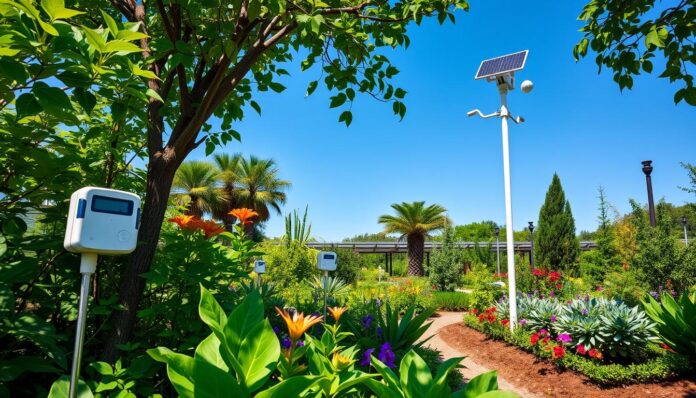Can technology make sustainable agriculture a global solution? The mix of permaculture IoT and sustainable agriculture is changing food production today.
Traditional farming is facing big challenges. New tech is coming to change farming. Permaculture IoT uses smart sensors to help farmers grow crops better and protect the environment.
The way we farm is changing fast. IoT devices could be worth 31 billion dollars by 2030. Farmers are finding tools to solve big problems in their fields.
IoT helps farmers understand soil and crops better. It makes farming more efficient and green. Farmers can now track moisture and plant growth, making farming smarter and more precise.
Key Takeaways
- IoT technologies are revolutionizing sustainable agricultural practices
- Smart sensors enable precise ecosystem monitoring
- Permaculture IoT applications reduce manual labor
- Data-driven farming improves resource allocation
- Technology makes agriculture more attractive to younger generations
Understanding Permaculture Principles
Permaculture is a new way to farm that works with nature. It was started in Tasmania in the 1970s by Bill Mollison and David Holmgren. This method turns old farming ways into a new, green practice.
Definition and Core Concepts
Permaculture is all about copying nature’s ways. It uses 12 main rules to help farming be green. These rules help make places that work well with nature.
- Observe and interact with natural systems
- Capture and store energy from multiple sources
- Obtain a yield that supports ecosystem health
- Apply self-regulation and accept feedback
Benefits of Permaculture
“Permaculture is about designing sustainable human settlements and agricultural systems that mimic the patterns and relationships found in natural ecosystems.” – Bill Mollison
Permaculture does more than just farm. It helps farmers:
- Reduce harm to the environment
- Bring back more life to the land
- Use resources better
- Make food systems strong and lasting
The Role of Sustainability
Sustainability is key in permaculture. It uses green tech and nature’s ways to make systems that can last. These systems might need less water and can make their own food.
| Permaculture Principle | Key Focus | Environmental Impact |
|---|---|---|
| Catch and Store Energy | Use solar, wind, and water | Less need for outside energy |
| Produce No Waste | Use resources over and over | Less waste in the environment |
| Design from Patterns to Details | Learn from nature’s ways | Build systems that can adapt |
What is IoT?
The Internet of Things (IoT) is changing how we use data and devices. It’s a big deal in farming, making it more sustainable and efficient. This is really important for permaculture.
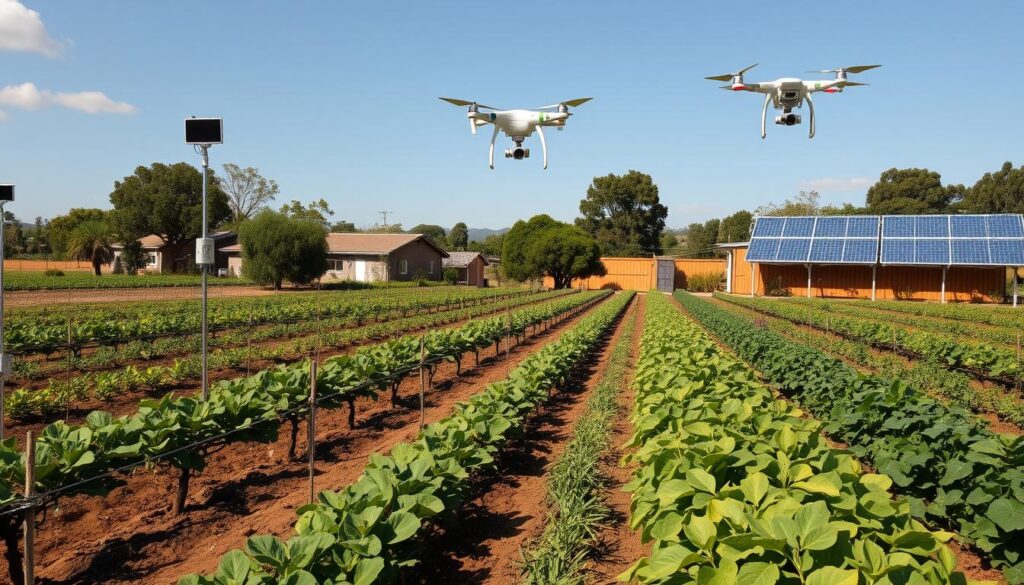
IoT connects devices to share and analyze data. It uses smart sensors and the internet. This lets farmers make smart choices in real-time.
Defining the Internet of Things
IoT mixes hardware, software, and networks to make smart systems. In farming, it changes how we grow food. It gives farmers new insights through data.
Key Components of IoT
- Sensors for environmental monitoring
- Wireless communication networks
- Cloud-based data processing platforms
- User-friendly interfaces
- Machine learning algorithms
Benefits of IoT in Agriculture
The IoT market in farming is growing fast. It was worth $12.3 billion in 2023 and will hit $31 billion by 2030. This shows how IoT is changing farming.
“IoT is not just about technology, but about creating sustainable, efficient agricultural systems that can feed a growing global population.” – Agricultural Innovation Experts
| IoT Application | Efficiency Improvement | Resource Impact |
|---|---|---|
| Smart Irrigation | 30% water efficiency | 20% production increase |
| Crop Monitoring | 10% labor efficiency | Reduced chemical inputs |
| Livestock Management | Real-time health tracking | Improved animal welfare |
By 2050, we’ll need 60% more food. IoT is a key solution for sustainable farming. It’s vital for our food future.
The Intersection of IoT and Permaculture
Agriculture is at a turning point, where technology and nature meet. Precision farming is changing how we grow food, blending new tech with green practices.
Why Combine IoT with Permaculture?
Putting IoT with permaculture opens up new ways to farm. Smart sensors and advanced monitoring systems let farmers use data to improve their land and crops.
- Real-time environmental monitoring
- Precision resource management
- Adaptive design strategies
- Enhanced crop yield prediction
Transformative Impact on Food Systems
IoT is changing farming by giving farmers deep insights. Precision farming tools help farmers use resources better, cut down on waste, and make farming more stable.
Technology is not replacing nature, but helping us understand and work with natural systems more effectively.
| IoT Technology | Agricultural Benefit | Productivity Improvement |
|---|---|---|
| Soil Moisture Sensors | Water Conservation | 30% Efficiency Increase |
| Drone Mapping | Site Assessment | 40% Faster Planning |
| AI Design Software | Ecosystem Simulation | 50% More Accurate Predictions |
By using these new methods, farmers can make farming better for the planet and people. They can grow more food in a way that’s good for the environment and ensures everyone has enough to eat.
Smart Soil Monitoring Techniques
Soil health is key to successful permaculture. Modern IoT technologies change how farmers manage their land. They now get deep insights into their soil’s ecosystem.
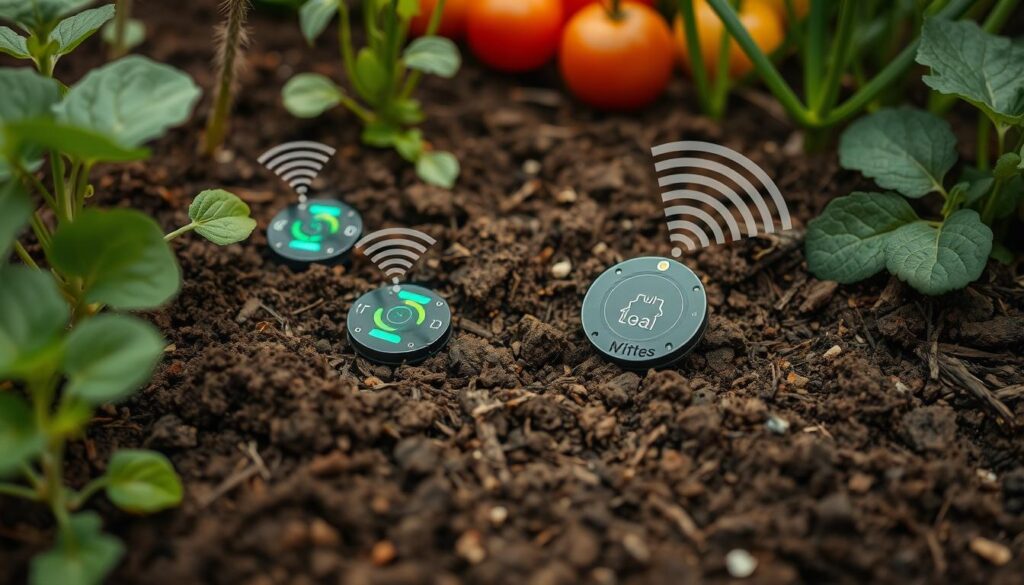
The Importance of Soil Health
Soil is more than dirt; it’s alive and vital for farming. IoT helps farmers understand and manage their soil better. This leads to better farming practices.
- Early pest detection can reduce yield loss by 20-40%
- Real-time soil data helps optimize crop management
- Precise nutrient tracking improves overall agricultural productivity
Advanced Soil Sensors for Comprehensive Analysis
Modern soil monitoring uses advanced sensors. These sensors measure many things at once. They track moisture, pH levels, and nutrients.
“The future of agriculture is data-driven, with soil health at its core.” – Agricultural Innovation Expert
Data Analytics for Intelligent Soil Management
IoT turns raw data into useful insights. Wireless sensors check soil every hour. This gives farmers the info they need for better farming.
| Sensor Type | Key Measurement | Agricultural Impact |
|---|---|---|
| Moisture Sensors | Water Content | Optimize Irrigation |
| pH Sensors | Soil Acidity | Nutrient Management |
| NPK Sensors | Nutrient Levels | Fertilizer Optimization |
Using these smart techniques, farmers can use up to 30% less water and fertilizer. This makes farming more sustainable and productive.
Climate Control in Permaculture
Modern permaculture design is changing farming with advanced weather forecasting and green tech. It brings smart climate management to farmers. This changes how they work with the weather.
IoT solutions are opening new ways to control the environment in farming. They let farmers watch and change important environmental factors with great precision.
Automated Microclimate Management
Advanced sensor networks give farmers real-time info on the environment. They can use this tech to:
- Track temperature changes
- Keep an eye on humidity
- Spot climate changes early
- Use smart systems to control the climate
Sensors for Temperature and Humidity
IoT sensors give detailed info on the microclimate. They catch small changes that old methods miss. This lets farmers act fast to manage the environment.
“Technology transforms agriculture from reactive to predictive approaches” – Sustainable Agriculture Research Institute
Integrating Weather Data into Design
Weather forecasting helps permaculture designers make systems that can handle changes. By looking at past and current data, farmers can make their farms stronger and more sustainable.
Green tech is making farming smarter and more sustainable. It brings hope for better farming in the future.
Water Management Systems
Water is key to any permaculture system. New IoT technologies are changing how farmers handle water. Smart irrigation and precision farming are making farming more water-friendly and sustainable.
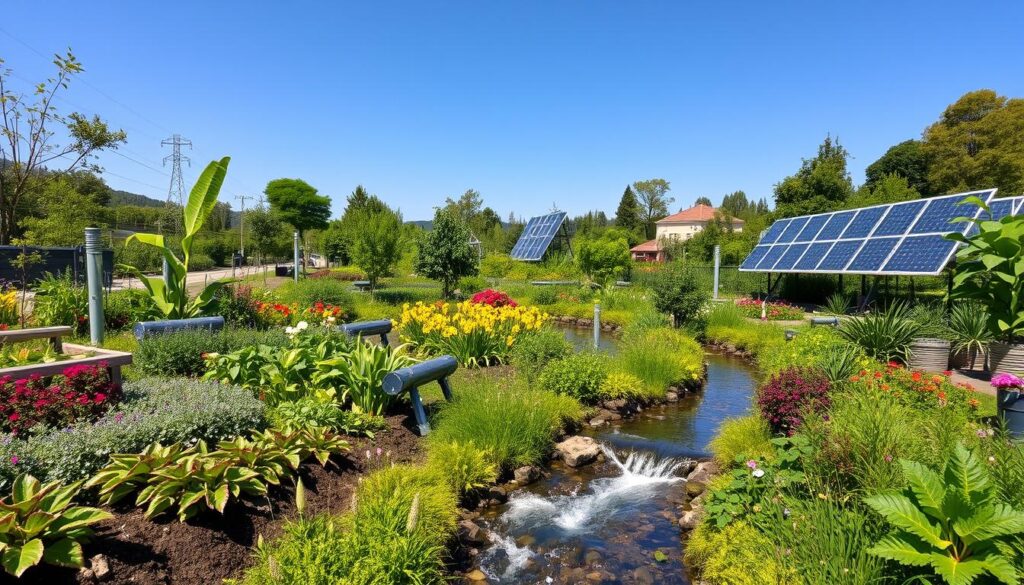
IoT Solutions for Efficient Irrigation
Modern farming is getting better at water management thanks to smart systems. New water harvesting methods use advanced sensors to check soil moisture levels accurately.
- Real-time soil moisture tracking
- Automated water distribution
- Precise irrigation scheduling
Rainwater Harvesting and Analysis
IoT rainwater systems help farmers use water better. They use smart sensors and data to improve water collection and storage.
Smart irrigation can cut water use by up to 50% compared to old methods.
Drought Prediction and Response
Now, precision farming includes drought prediction tools. These tools use weather, soil, and plant data to help farmers manage water better.
| IoT Water Management Benefit | Potential Improvement |
|---|---|
| Water Use Efficiency | 10-20% Reduction |
| Crop Yield Optimization | 20-30% Increase |
| Operational Cost Savings | Up to 30% Reduction |
By using these advanced IoT tools, farmers can make farming more sustainable. They can use water better and reduce harm to the environment.
Crop Monitoring Solutions
The digital revolution is changing how we manage crops. Precision farming is leading the way, using new tools to keep crops healthy and productive.
Today’s farmers use advanced tech to understand their crops better. Integrated monitoring systems let them track important farm data in real-time.
Real-Time Crop Health Monitoring
IoT technologies have changed crop management. They give farmers instant health checks. Now, farmers can track many things with great accuracy:
- Soil moisture levels
- Nutrient concentrations
- Plant stress indicators
- Microclimate conditions
Using Drones and Satellite Imagery
Drone and satellite imaging give farmers amazing tools for monitoring crops. These technologies capture detailed data about crop health.
| Technology | Key Benefits | Performance Impact |
|---|---|---|
| Drone Imaging | Detailed field-level analysis | Up to 30% yield improvement |
| Satellite Monitoring | Large-scale crop tracking | 25% enhanced resource management |
Disease Prediction and Management
Precision farming helps farmers manage diseases better. It uses data to predict and prevent problems before they start.
*”Data is the new soil in modern agriculture”* – Agricultural Innovation Expert
IoT in crop monitoring is a big step forward. It can increase yields by up to 30% and make farming more efficient. These tools are changing farming for the better.
Waste Management Innovations
Sustainable agriculture is changing how we manage waste with new eco-friendly tech. Permaculture systems are leading the way by turning waste into valuable resources. They create closed-loop processes.
IoT-Enabled Composting Systems
Modern permaculture uses advanced IoT sensors to improve composting. These smart systems track important factors like:
- Temperature variations
- Moisture content
- Gas emission levels
- Decomposition rates
Waste Cycle in Permaculture Design
Zero waste is key in permaculture. Farmers use smart waste management to cut down on environmental harm. This also boosts farm productivity.
“Waste is just a resource in the wrong place” – Permaculture Design Principle
Monitoring and Optimizing Waste Resources
Farmers can turn organic waste into useful inputs with data-driven management. IoT helps track and improve waste streams. This supports sustainable farming goals.
| Waste Resource | Potential Use | Environmental Impact |
|---|---|---|
| Food Scraps | Compost Production | Reduces Methane Emissions |
| Garden Waste | Soil Amendment | Improves Soil Health |
| Agricultural Residues | Biomass Energy | Renewable Energy Generation |
Permaculture systems show a new way to manage waste with eco-friendly tech. They aim to reduce waste and use resources more efficiently.
Energy Management in Permaculture
Permaculture is changing how we manage energy in farming. It uses new, green tech to cut down on carbon and make energy use better.
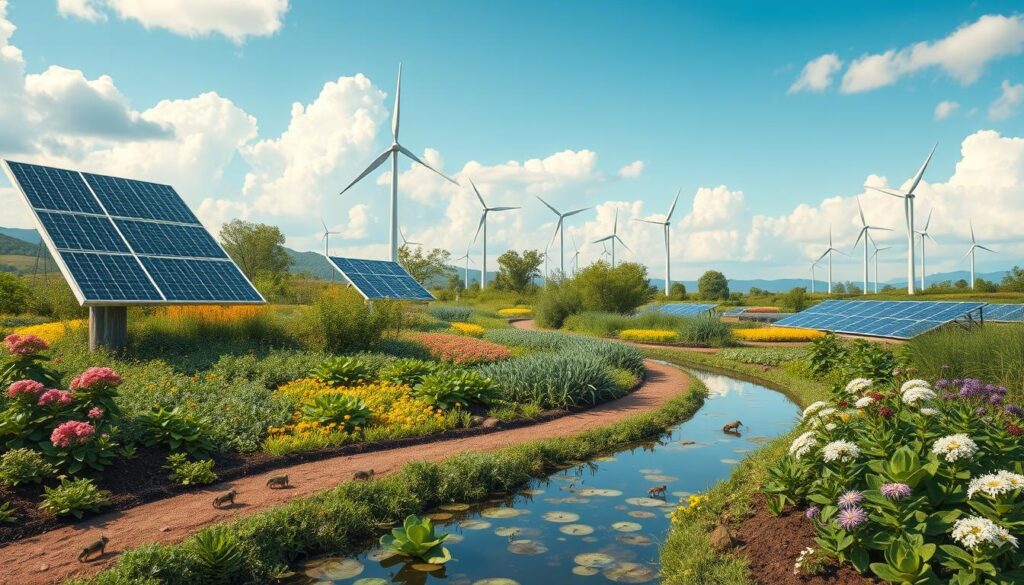
Renewable Energy Integration
Today’s permaculture uses many green energy ways to make farms sustainable. Farmers use different energy sources to run their farms, like:
- Solar panels
- Wind turbines
- Biogas generators
- Hybrid renewable energy networks
Monitoring Energy Consumption
Smart meters and IoT devices help track energy use. They let farmers:
- See when they use the most energy
- Make energy use better
- Save energy they don’t need
Smart Grids in Permaculture
Energy systems that connect farms to bigger networks let them sell extra green energy. This helps the local grid.
| Energy Source | Efficiency | Cost Reduction |
|---|---|---|
| Solar Panels | 75-80% | 40-50% |
| Wind Turbines | 35-45% | 30-40% |
| Biogas Systems | 50-60% | 25-35% |
“The future of agriculture lies in sustainable energy management and intelligent resource utilization.” – Sustainable Agriculture Research Institute
Permaculture shows a new way to manage energy in farming. It’s green, cuts down on harm to the planet, and makes farms strong and self-sufficient.
The Role of Community Data Sharing
Community data sharing is key in modern sustainable agriculture. It lets farmers work together and improve their permaculture practices. With data analytics, farming communities can build strong networks. These networks change how farming is done.
Collaborative Pest Management
Data analytics gives farmers new tools to tackle farming challenges. They can share info on pests in real-time. This helps communities plan ahead to protect crops.
- Rapid disease detection across regional landscapes
- Collective tracking of pest migration patterns
- Reduced reliance on chemical interventions
Sharing Resources and Best Practices
Sustainable agriculture grows when farmers share knowledge. Community platforms let farmers exchange vital info on growing crops and keeping soil healthy.
“Knowledge shared is power multiplied” – Permaculture Network Principle
Building Local Networks
Local food networks are powerful learning ecosystems. They help farmers grow together and become stronger.
| Network Characteristic | Community Impact |
|---|---|
| Information Flow | Enhanced Learning Opportunities |
| Shared Resources | Cost Reduction |
| Collective Problem Solving | Increased Agricultural Efficiency |
By using community data sharing, farmers can build strong, connected systems. These systems boost local food security and support sustainable farming.
Enhancing Biodiversity with IoT
In the world of sustainable agriculture, IoT is changing how farmers work with ecosystems. It’s making our way of managing habitats better, giving us new insights into life’s complex systems.
Today’s permaculture uses smart sensors to track biodiversity. These tools give farmers important data on how species interact and how populations change.
Monitoring Species Diversity
IoT helps farmers understand their ecosystems better. They use:
- Acoustic sensors for wildlife tracking
- Camera traps for species identification
- Remote sensing technologies
- AI-powered data analysis
Supporting Pollinator Health
Pollinators are key to sustainable farming. IoT lets farmers watch over bee populations and flower visits closely.
“Technology allows us to see the invisible connections in our ecosystems” – Ecological Innovation Research Center
Data-Driven Habitat Management
AI and IoT help farmers make better choices for their habitats. They use data to design better habitats and understand how species move.
- Real-time environmental monitoring
- Precise ecosystem mapping
- Early warning systems for potential disruptions
By using these new methods, farmers can make their ecosystems stronger and more balanced. This supports both farming and nature.
Ethical Considerations in IoT Applications
As sustainable agriculture uses more advanced technologies, we must think about the ethics of data analytics. The Internet of Things (IoT) is changing fast. It brings new chances and big ethical questions that need careful thought.
Privacy Concerns in Data Collection
Data collection in farming raises big privacy issues. Farmers use IoT sensors to gather valuable data. This creates questions about who owns the data and how it should be shared.
- Protecting individual farm data from unauthorized access
- Establishing clear data ownership frameworks
- Creating transparent consent mechanisms
- Implementing robust cybersecurity protocols
Ensuring Equitable Technology Access
The digital gap in farming is a big problem. Small farmers often can’t afford the latest IoT tech. This leads to unequal access to technology.
“Technology should empower all farmers, not just those with substantial financial resources.”
| Technology Access Barriers | Potential Solutions |
|---|---|
| High Implementation Costs | Community technology sharing programs |
| Limited Technical Knowledge | Training and capacity-building workshops |
| Infrastructure Limitations | Government and NGO support initiatives |
Responsible Use of Technology
Using technology wisely in data analytics is key. We need to balance new tech with nature and society. Permaculture teaches us to use tech in a way that helps, not harms.
By focusing on ethics, working together, and designing for everyone, IoT can help farming be more sustainable. It supports the goals of caring for the environment and fairness for all.
Future Trends in IoT and Permaculture
The world of sustainable farming is changing fast. New tech in precision farming and data analysis is leading the way. The mix of IoT and permaculture could solve big problems in farming worldwide.
Predictive Analytics and AI Integration
New predictive analytics are changing how farmers manage crops. The market for precision farming is set to hit $27.81 billion by 2031. Artificial intelligence is key in making farming systems better.
- Advanced AI algorithms can predict crop yields with great accuracy
- Machine learning lets farmers monitor the environment in real-time
- Data analysis helps farmers make better choices
Emerging Technologies to Watch
Several new technologies are set to change permaculture:
- Edge computing for quicker data processing
- 5G for fast sensor communication
- Advanced robots for precise farming
“Technology is the bridge between traditional farming wisdom and future sustainable practices.”
The Future of Sustainable Agriculture
With the world’s population set to hit 9.7 billion by 2050, IoT in permaculture offers hope. The IoT agriculture market was $13.76 billion in 2022. This shows the huge potential of these technologies.
But, there are still challenges like high costs and poor rural internet. Yet, the benefits of more food, less harm to the environment, and better use of resources make IoT in permaculture very promising.
Case Studies: Successful IoT Implementations
Permaculture IoT applications are changing sustainable agriculture with new tech. Real-world examples show how smart tech can improve farming.
Innovative Farm Transformations
Across the globe, IoT in permaculture is making a big impact. Many projects show how tech can change farming:
- Modular Farms in Canada grows 3,800 plants in one module with hydroponics
- myfood greenhouse project makes 400 kg of organic veggies and 50 kg of fish yearly
- Japanese connected greenhouses in Siberia produce 1,000 tons of cucumbers and tomatoes yearly
Lessons from Pilot Projects
Successful IoT projects offer valuable lessons for sustainable farming:
| Technology | Efficiency Improvement |
|---|---|
| Smart Irrigation | 30% more water and fertilizer saved |
| Smart Greenhouse Technology | 20% better quality and production |
| Advanced IoT Technologies | 10% more efficient labor |
Scaling Successful Implementations
The future of farming is in growing IoT solutions. With the market set to hit $19,007.8 billion by 2027, small ideas can change food production worldwide.
Technology is not just improving agriculture—it’s reimagining our entire approach to food production and environmental stewardship.
Conclusion: The Promise of IoT in Permaculture
IoT in permaculture is changing sustainable agriculture. With agriculture causing about 25% of greenhouse gas emissions, new tech is key. It helps make food systems more stable.
IoT is changing how farmers manage resources. It cuts down fertilizer use by a lot. AI helps guess crop yields and lessen environmental harm. The AI in agriculture market is growing fast, showing its big impact.
Summary of Benefits
IoT in sustainable agriculture has many benefits. It uses real-time data and smart sensors. This helps farmers use resources better, use less chemicals, and keep ecosystems healthy.
This tech tackles big problems like less land, more people, and protecting the environment. It’s a big step forward.
The Future of Sustainable Agriculture with IoT
The future of farming is smart and data-driven. It combines tech with nature. AI will keep improving, making farming more efficient and green.
This will help feed more people and protect our planet. It’s a hopeful future for farming.
Call to Action for Farmers and Innovators
Farmers, tech experts, and leaders need to work together. They should invest in smart farming and support research. This will create a better, more productive farming future.

